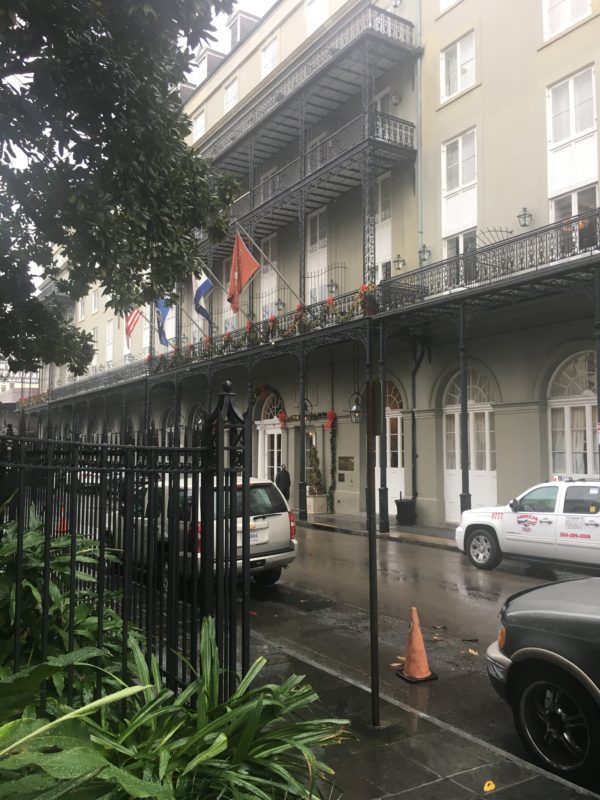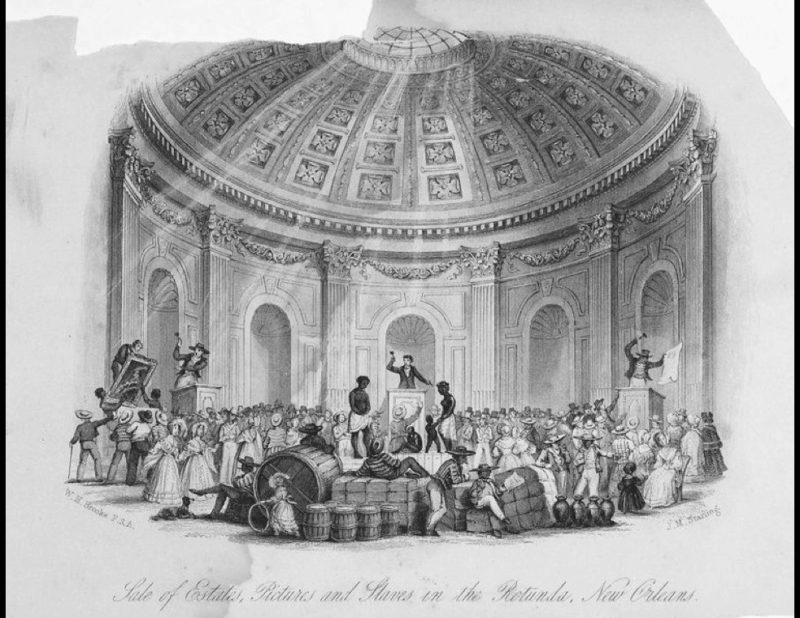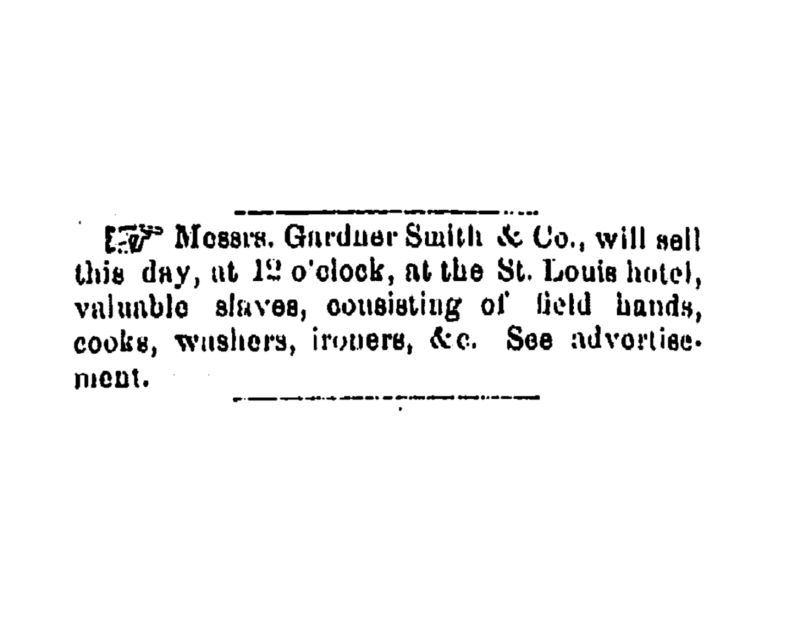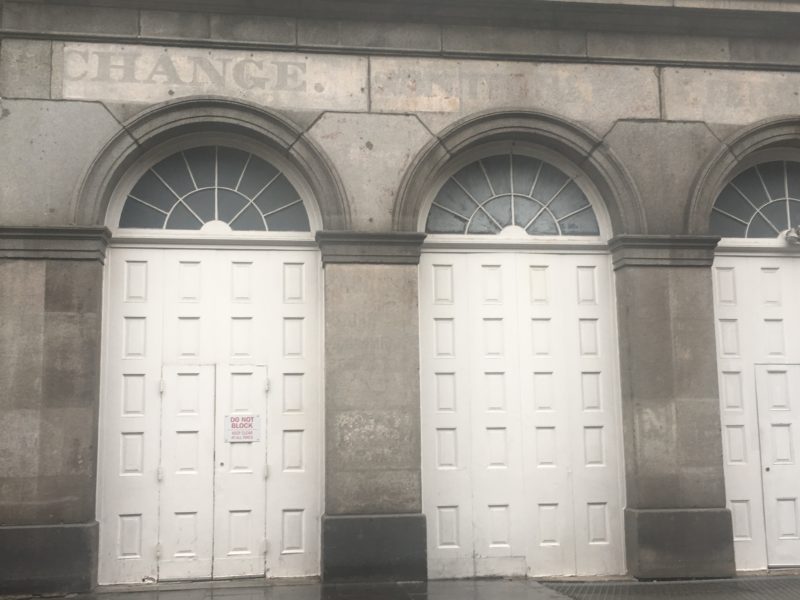
The front of the Royal Orleans Hotel on St. Louis Stree
New Orleans is a city rich in culture from its diverse history. The Crescent City has a long history of French, Creole, Spanish, and American influence that is still prevalent today in various parts of the city. One of the most prominent parts of American history, and especially in New Orleans, is slavery. In the modern French Quarter stands the Omni Royal Orleans Hotel, located at 621 St. Louis Street. However, in this location in the 1800s stood the St. Louis Exchange Hotel – a hub of political, economic, and social life in New Orleans and largely throughout the Deep South. This hotel also was one of the main locations for slave auctions in the mid-1800s in the South. These extravagant events exemplified the injustices of slavery by focusing on the importance of sales and making money rather than the justice of those for sale. While slavery was one of the major focuses of the St. Louis Exchange Hotel, it is obviously omitted from the culture of the Omni Royal Orleans Hotel today. However, both then and now, this location has been one of wealth, social prowess, and political and economic rise.
At the mouth of the Mississippi River, New Orleans was one of the most important trading ports in early America. Due to New Orleans’ proximity to the Caribbean, it was the main American exporter of Southern materials and food to the slave islands, which made New Orleans planters, traders, and sellers extremely wealthy. While the Deep South was exporting goods in New Orleans, the city was also importing slaves from the Caribbean and other Southern states. It was common for Southern states to send their slaves to be sold in New Orleans because slaves sold for higher prices due to the prominence and upper class influence on trading auctions. New Orleans slave traders had the ability to be critical of the slaves they were selling simply because they had the means to do so as a result from the consistently high demand of slaves in the city during the mid-1800s. Numerous buyers from upper Louisiana and Mississippi traveled to New Orleans specifically to buy “high quality” slaves. Additionally, New Orleans had an abundance of jails where slaves to be sold were held, and additional sales rooms outside of the main auction rooms. New Orleans was known for having slave auctions in public, grand places, rather than keeping them as small, semi-shameful events like many other cities did during the 19th century. The social status held by these slave trades attracted a wealthy, aristocratic audience to witness and participate in such auctions.
Before the St. Louis Exchange Hotel opened in 1843, the City Exchange was where slave auctions took place. The City Exchange, opened in 1838, existed in the same location as the St. Louis Exchange Hotel as a restaurant and popular trading post. In the early 1840s, James Hewlett, the owner of the City Exchange, decided to make the building a “Creole Palace,” that would represent the European and Creole cultures of the city. The St. Louis Exchange Hotel was completed in 1843, and instantly became a hub for trading, lavish societal events, and political discussion of the New Orleans planter and business aristocracy. A description of the Hotel from The Daily Picayune claims the hotel to have magnificent style with classic and innovative devices, showcasing its meticulous and accommodating features. The hotel hosted politicians and wealthy businessmen as its main guests, exemplified by a Whig meeting that was held there in 1838, which, while the building was still the City Exchange at this time, had the same status of wealth and importance in the city.

An image of an auction taking place at the rotunda, 1842
Featured events at the St. Louis Exchange Hotel were slave auctions, which were held at the Rotunda and were described to be high-end social gatherings that appeared to be extremely formal societal events for those watching and participating. Below is a picture of an auction occurring at the Rotunda taken in 1842. John Theophilus Kramer describes the scene of a slave auction where “richly dressed gentlemen are helping themselves to fine liquors and delicacies,” and “ladies, splendidly dressed in black silk and satin, and glittering with precious jewels, are entering the hall.” This description portrays the luxuries not only of owning slaves, but also of buying and selling them. The wealthy saw slave auctions as an opportunity to gain social status through appearance, along with economic gains of purchasing slaves.
During this time, the advertisements of slaves for sale were posted in newspapers. The main New Orleans newspaper used for slave auctions at the St. Louis Exchange Hotel was the Daily Picayune, which in modern times is the Times-Picayune. There are various accounts of slaves, as well as other goods, being posted for sale in this newspaper. For example, in an 185o advertisement, a sugar plantation and its slaves were put up for auction at the rotunda. The advertisement starts by describing the plantation, and then proceeds to list the slaves, mentioning only their first names and ages. This list of names is similar to how kitchen spices were sold at the time, using an itemized list, emphasizing how essential slavery was to New Orleans life and how little anyone thought about the freedom and rights of the people being sold.

Advertisement from The Daily Picayune, New Orleans in the issue released on October 20th, 1860.
Another example of such advertisements is one published in October of 1860. The advertisement, pictured here, simply states that the auction will occur at the St. Louis Hotel, then includes the name of the company selling the slaves, and the skills of those slaves, failing to mention any characteristics of the enslaved people themselves. Once more, the only important characteristic regarding the slave trade and slave auctions in New Orleans at this time is wealth. The name of the seller is stated in order to assure that buyers know who will be receiving payment. The affluence and culture of the slave auctions that took place at the St. Louis Exchange Hotel are representative of the time-period, and how little liberty and recognition slaves had amidst slave societies.
After the Reconstruction Era, most of the French Quarter went into a period of atrophy, including the St. Louis Exchange Hotel. In 1912, the Hotel officially closed and did not reopen until 1960. Preservationists of the time-period wanted to reestablish the culture and uniqueness of the French Quarter. In an effort to do this, the Royal Orleans Hotel was reopened in 1960, where the St. Louis Exchange Hotel stood before it.
Similar to its predecessors, the Royal Orleans (now the Omni Royal Orleans Hotel) again became the epitome of affluent society, and housed many movie stars, politicians, and musicians. The Led Zeppelin song “Royal Orleans” is based on the Hotel, as well as the book Hotel by author Arthur Hailey. The Royal Orleans Hotel still is still a high-end hotel that hosts conventions, meetings, parties, and other societal events. While the Hotel has been rebuilt, there are still the original arches from the St. Louis Exchange Hotel on the Chartres Street side.

Image of the arches currently on Chartres Street of the Royal Orleans Hotel. The remains of the word “Exchange” from the St. Louis Exchange Hotel can be seen in the leftmost arch.
These arches are pictured here, along with a current photo of the Royal Orleans Hotel (above), decorated for the holiday season. The continuation of the Hotel as a pillar of affluent society in New Orleans still exists today. While slavery clearly is no longer a part of the Royal Orleans Hotel, the history of what occurred in this spot is still an important part of New Orleans culture. It has helped to shape not only the entire city of New Orleans that we know today, but also the distinguishing features of the French Quarter that are such monumental parts of what makes New Orleans so appealing.
Sources:
“Advertisement.” The Daily Picayune, February 2nd, 1850, New Orleans. America’s Historical Newspapers. Accessed 6 Dec. 2017.
“Advertisement.” The Daily Picayune, October 20th, 1860, New Orleans. America’s Historical Newspapers. Accessed 6 Dec. 2017.
“Advertisement.” The Daily Picayune, October 20th, 1860, New Orleans. America’s Historical Newspapers. Image. Accessed 6 Dec. 2017.
DeMers, John, The Tumultuous Life and Times of the Omni Royal Orleans Hotel, “Hotel New Orleans | History | Omni Royal Orleans.” Accessed 6 Dec. 2017.
“Hotel New Orleans | History | Omni Royal Orleans.” Accessed 7 Dec. 2017. https://www.omnihotels.com/hotels/new-orleans-royal-orleans/property-details/history.
Kramer, John Theophilus. The Slave Auction. (Boston: 1859). Slavery and Anti-Slavery. Gale. Tulane University. 6 Dec. 2017.
McInnis, Maurie D. “Mapping the Slave Trade in Richmond and New Orleans.” Buildings & Landscapes: Journal of the Vernacular Architecture Forum 20, no. 2 (2013): 102–25. https://doi.org/10.5749/buildland.20.2.0102.
“Politely; Drawing; Reception; St. Louis Hotel; Gratified; According.” The Daily Picayune, November 21st, 1838, New Orleans. America’s Historical Newspapers. Accessed 5 Dec. 2017.
Rotunda Picture Citation: Schomburg Center for Research in Black Culture, Manuscripts, Archives and Rare Books Division, The New York Public Library. “Sale of estates, pictures and slaves in the Rotunda, New Orleans.” New York Public Library Digital Collections. Accessed 6 Dec. 2017.
Silverman, Emily. Arches of Omni Royal Orleans Hotel. Image. 6 Dec. 2017
Silverman, Emily. Front of Omni Royal Orleans Hotel. Image. 6 Dec. 2017.
Tadman, Michael. “Slave Trading in the Ante-Bellum South: An Estimate of the Extent of the Inter-Regional Slave Trade.” Journal of American Studies 13, no. 2 (1979): 195–220.
“Whig; City Exchange; St. Louis; Committee,” The Daily Picayune, February 4th, 1838, New Orleans. America’s Historical Newspapers. Accessed 5 Dec. 2017.
 NOLAbeings Multimedia artist Claire Bangser created NOLAbeings as a portrait-based story project that marries...
NOLAbeings Multimedia artist Claire Bangser created NOLAbeings as a portrait-based story project that marries...  Voodoo in New Orleans: Reviving history: New Orleans fortune telling This article takes a deep dive into the history of Voodoo in New Orleans, its hybridization with Catholicism, and its present-day place in the city's culture. The author visits fortune-tellers in the French Quarter, using their guidance as a tool for introspection rather than a deterministic predictor of the future. Through her experiences in New Orleans, the author feels a mystical connection to both the past and the future.
Voodoo in New Orleans: Reviving history: New Orleans fortune telling This article takes a deep dive into the history of Voodoo in New Orleans, its hybridization with Catholicism, and its present-day place in the city's culture. The author visits fortune-tellers in the French Quarter, using their guidance as a tool for introspection rather than a deterministic predictor of the future. Through her experiences in New Orleans, the author feels a mystical connection to both the past and the future. 
[…] https://www.vianolavie.org/2017/12/13/the-st-louis-exchange-hotel-and-the-new-orleans-slave-trade/ […]
[…] Download Image More @ www.vianolavie.org […]
[…] Download Image More @ www.vianolavie.org […]
[…] An excerpt from vianolavie.org describes a prosperous scene inside the rotunda: […]